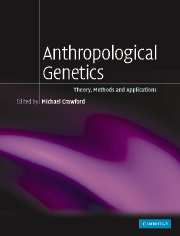Preface
Published online by Cambridge University Press: 05 June 2012
Summary
The primary purposes of this volume are: (1) to define the field of anthropological genetics in lieu of the recent developments in molecular genetics; (2) to update the materials presented in earlier volumes on anthropological genetics. This update is essential because the recent technological developments have provided tools that can now be utilized to answer controversial evolutionary and historically based questions. The earlier four volumes dealing with anthropological genetics (Crawford and Workman, 1973; Mielke and Crawford, 1980; Crawford and Mielke, 1982; Crawford, 1984) preceded the molecular genetics revolution and focused primarily on population structure and the beginnings of genetic epidemiology. A glimpse of some of the technological and methodological innovations and their applications to anthropological genetics was contained in the special issue of Human Biology, devoted to the arrival of the new millennium and the future of the field (Crawford, 2000).
I was approached by the Executive Committee of the American Association of Anthropological Genetics (AAAG) and asked to develop a volume that would define the field of anthropological genetics and could be used as a textbook for advanced undergraduate students and graduate students. After several meetings with committees to discuss the contents of such a volume, I proposed that the book be divided into an Introduction, Conclusion plus four topical categories: Theory, Methods, General Applications, and The Human Diaspora. Initially, 19 sets of authors agreed to write chapters covering what I considered the most significant topics in anthropological genetics.
- Type
- Chapter
- Information
- Anthropological GeneticsTheory, Methods and Applications, pp. ix - xPublisher: Cambridge University PressPrint publication year: 2006

